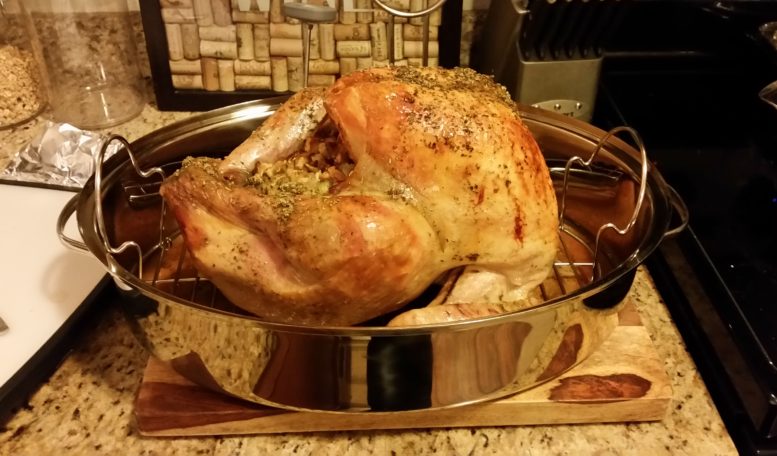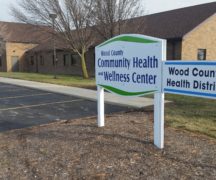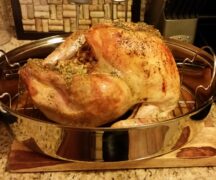By JAN LARSON McLAUGHLIN
BG Independent News
Sure, Butterball has a turkey hotline for novice Thanksgiving cooks on Thursday. But it’s doubtful that their emergency operators have to tell many people not to use the hot cycle of the dishwasher to thaw out their frozen turkeys.
That was one bit of advice dished out by the Wood County Health District to a local food establishment years ago.
When asked last week for some tips on how Thanksgiving hosts can prepare a feast without poisoning their guests, the restaurant inspectors revisited some unforgettable turkey tragedies.
In many cases, restaurants want to serve up all the holiday favorites, but just don’t have room to safely thaw out giant turkeys in their refrigerators. So they devise some creative methods.
Registered sanitarian Julie Nye told about the turkeys thawing in a mop sink. That’s a no-no.
Then there was the turkey in the dishwasher, with the appliance working double time to also wash all the vegetables for the trimmings.
“They thought it would thaw faster,” Nye said. “There are creative ways to thaw that become a public health nightmare.”
The best advice is to plan ahead, so the bird has time to thaw in the refrigerator. If you find your turkey still slightly frozen on Thanksgiving morning, don’t panic. It is safe to place a turkey under cold running water to help it thaw, registered sanitarian Jillian Bodey said.
Following are more safety tips from the health district sanitarians, so your guests don’t get sick from the feast.
Top on the list – wash your hands … often.
“The number one thing we can remind people to do is handwashing,” Nye said. That rule is especially important in between handling an uncooked turkey and any food item raw and ready to eat.
“Handwashing is top for everybody,” said Lana Glore, director of environmental services at the health district. “It’s amazing what that will prevent.”
And for good measure, wash the produce even if it’s labeled “pre-washed,” Glore said. You never really know if the pre-washing was as thorough as you would like.

Health district’s Jillan Bodey, Lana Glore and Julie Nye offer food safety tips for Thanksgiving.
To avoid cross contamination, make sure you wipe up turkey juice that somehow seems to get everywhere in the kitchen. Don’t cut raw vegetables on surfaces used for the turkey, unless they are thoroughly cleaned first. “You need to sanitize surfaces and cutting boards,” Nye said.
Temperatures are especially tricky. Turkey must reach a temperature of 165 degrees, so use a probe thermometer with numbers, Bodey said. Using an inexact meat thermometer that has readings of “not done,” “done,” and “overdone” is not good enough when it comes to a big bird like a turkey.
Make sure you insert the thermometer into a thick part of the turkey to get a true reading. Remember, turkeys cooked with the dressing stuffed inside will take longer to cook. The dressing may get done before the turkey, but it’s better to have the dressing dried out a bit than have an undercooked bird.
Besides, what’s gravy for if not to dump on items like dry dressing?
Safe food temperatures also come into play when holding foods for a period. Cold foods should be kept at temperatures of 41 degrees or below, while hot foods must be kept at 135 degrees or above.
Though Thanksgiving at your home may be a day of people grazing on food over a period of hours, the sanitarians cautioned about leaving foods out at room temperature.
“If people pick at food all day long, that’s not the best practice,” Bodey said.
“The best case scenario is if everybody eats and then you put it away,” Glore said. Or keep the food in warmers or the oven.
The rule at restaurants is that food can be left out at safe temperatures for four hours – then the remaining portions have to be thrown out.
To avoid the spread of sickness among your guests, make sure there are enough serving utensils so people don’t have to dip their used silverware into bowls or platters of food being passed.
And since the day after Thanksgiving often means plates of warmed up leftovers, the sanitarians advised that heating of bulk leftovers should again hit the 165 temperature.
Just when you thought it was safe to move onto dessert with no worries – hold that whipped cream.
The sanitarians noted the emergence of many desserts sold online. There is a “cottage food rule” that allows home bakers to sell their items as long as they don’t require refrigeration.
For desserts like pumpkin pie, cream pie or any item that must be kept cold, the risk levels are higher – and so are the standards for sales to customers.
“Just make sure you get it from a licensed person or food establishment,” Glore said. “You wouldn’t want to buy from anyone that isn’t approved.”





